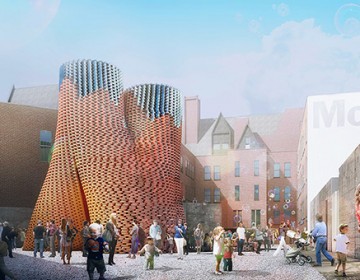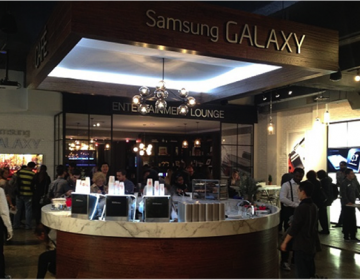Anywhere, Anywhere Out of the World: Parreno’s Audiovisual Art in Paris

By Michael Valinsky
In a special report from Paris, SoundCtrl contributor Michael Valinsky shares his experience of Phillipe Parreno’s takeover of the Palais de Tokyo.
The Parisian Palais de Tokyo opens its doors to international installation artist Philippe Parreno for a one-of-a-kind solo show entitled “Anywhere, Anywhere Out of the World“. While the show opened in October, it is still an essential winter must-see.
The show is a response to a free rein given to the artist by the museum. Parreno decided to lay out a series of audiovisual pieces and disperse his work throughout the museum. It’s the first time an artist ever took on the task of filling up the entire space of the museum by himself.
It seems that the idea of the show is to play around with the idea of movement. How far do we have to move around to hear certain frequencies? Or tune into a clip, audio or visual? Is it possible to see and hear the same thing? Most importantly, Parreno shows us that the exhibit is a medium of its own. The space will breathe at its own rhythm, convey its own messages and react to the pieces placed by the artist in the same way that a viewer would. In that sense, Parreno creates a soundspace that mirrors the interior organism of the exhibition space. We are mere molecules floating in and out.
The entire space, even the outdoors, is taken up by Parreno’s work, with light installations following us all the way to the ticket stand, an installation in and of itself. From the outset, the viewer can hear a collection of ambiguous, often unintelligible sounds. The immediate assumption is that they are emanating from a distant film being projected on LED lights on the main floor. However, the closer you move towards the film, the less you can see and the less you can hear the sounds you originally heard at the entrance.
Let’s say that for most of the exhibit, you’ll be looking around for a sound that you heard moments ago. The sounds are always changing and always sound familiar, so you’re constantly looking for something you’re already hearing. These sounds, however elusive they may be, all take the shape of multimedia works: lights installations, film projections, pianos, moving walls, human beings (in this case a series of little girls).
Parreno is interested in exploring the idea of collaboration for all intents and purposes. This means that he is not only pushing for a collaboration between his audience and himself, but between his audience and the space, the space and himself, and other artists and himself, including artists featured in most of the works in the exhibition. In that sense, as viewers, we are asked to look at works of collaborations and to contribute to the production of the work merely by interacting with it.
While we obviously interact with the works displayed, the works themselves interact with those that exist outside of the museum space. Most of Parreno’s pieces are takes on dance performances by the Merce Cunningham Dance Company, or interpretations of sheet music. The light installations have a pulse specific to the notes of a song. For instance, in one room, the light will go on and off to allow the viewer to see the blacklight paintings on the wall but also to allow the viewer to focus their attention on the sounds coming from the other room, which are pieces of Stravinsky’s Petrushka.
It would be just as hard to characterize this exhibit as a sound art exhibit as it would be to think of it as a series of light installations. The compounded effect of both media creates a space in which space is completely suspended. We are projected into Parreno’s dramatic composition, surrounded by the spectral presence of deceased artists and finished projects. It is truly uncanny, and you never really know where you are or what’s coming next. I guess that’s the great thing about a space like Palais de Tokyo, you can walk around for ever and still feel like you haven’t moved.
The show is up until January 12th so if you happen to find yourself wandering the streets of Paris, definitely hit up the Palais de Tokyo.
More information on the artist here.










